Tropical Entomology - Avocado Thrips
Flower thrips, Frankliniella kelliae, Frankliniella bispinosa, and red-banded thrips, Selenothrips rubrocinctus (Thysanoptera: Thripidae)
-
Description
Flower Thrips
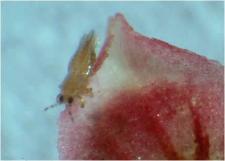
Flower thrips are yellowish, about 1.5 mm long with yellowish legs and two pairs of wings fringed with narrow hairs. Larvae are pale yellow. The small eggs are laid singly in the panicle or fruit tissue. They hatch into larvae which are almost transparent. The complete life cycle takes around 4-5 weeks. These thrips are present during the dry season and are noticeable when flowering starts. Red banded thrips are similar in shape but have a distinct red band on the abdomen during its immature development.
Red-Banded Thrips
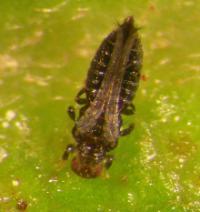
Red-banded thrips are found on leaves and fruits and the adults are dark in color. They have been a serious pest of cacao in the French West Indies from as early as 1901 (Russel, According to Hill (1975), red-banded thrips have an almost completely pantropical distribution, but has not been recorded in Australia while records are rather scattered in some other areas. In Taiwan symptoms similar to those caused by H. haemorrhoidalis result from the feeding of S. rubrocinctus (Giard). This species can be a problem in California, Florida, South-Africa-Australia, Reunion and Taiwan.
-
Damage
Part of plant damaged: Flowers and Fruits (flower thrips), Leaves and Fruit (red banded thrips).
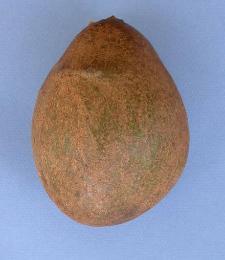
Damage by red banded thrips on Avocado fruitFlower Thrips
Flower thrips infestations can be in huge numbers causing excessive flower drop or fruit deformation. Infestations on avocado are usually the result of adult thrips invading abruptly and in very large numbers, from a large number of other hosts such as mango, litchi and a range of subtropical fruits and other flowering plants. Red-banded thrips feed on leaves and fruit. Infested leaves are spotted on the upper surface with dark reddish brown fecal pellets. Heavy feeding on fruit causes a russetted appearance, cracking and decay. Red-banded thrips damage fruit and tend to feed on the larger and more mature fruit. They are found most frequently where two fruits are in contact or where a leaf contacts the fruit. Fruits are damaged by slight russetting, then by cracks followed by decay.
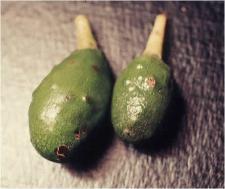
Eggs of flower thrips inserted into an avocado fruitRed-Banded Thrips
In Florida, and Australia, infested leaves are spotted on the upper surface with dark reddish brown fecal pellets. According to Hill (1975), the red-banded thrips feed on the ventral leaf surfaces. Damaged areas turn rusty with numerous small, shiny black spots of excreta and edges of affected leaves curl up. Heavy feeding on fruit causes a russetted appearance, cracking and decay. Greenhouse thrips damage fruit and tend to feed on the larger and more mature fruit. They are found most frequently where two fruits are in contact or where a leaf contacts the fruit. Fruits are damaged by slight russetting, show a leathery scarring and cracks on the skin.
-
Life Cycle
Flower Thrips
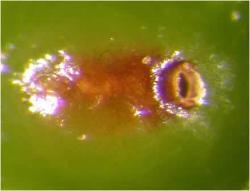
Eggs of flower thrips inserted into an avocado fruitFlower thrips lay small eggs singly in the panicle or fruit tissue. They hatch into larvae which are almost transparent. The complete life cycle takes around 4-5 weeks. Red-banded thrips insert their eggs into the leaf tissue. They are white, kidney-shaped and about 0.25 mm long (Hill, 1975). The first and second nymphal stages are yellow with a bright red b around the base of the abdomen. When fully grown, the second instar is about 1 mm long. The tip of the nymph’s abdomen is turned up and carries a drop of excreta on anal setae (Hill, 1975). The pre-pseudo pupa is yellowish with red eyes, with a red band across the first three abdominal segments. The pseudo-pupa has an almost similar appearance as the pre-pseudo pupa with larger wing knobs (Hill, 1975). The adult female is dark brown and just over 1 mm long. Males are smaller and rare (Hill, 1975). Reproduction by the red-banded thrips is parthenogenetically (Avidov and Harpaz, 1969). Females live about 7 weeks and lay an average of 25 eggs. Eggs hatch in 12 - 18 days (Hill, 1975). The nymphal stage lasts 6 - 10 days and the pupal stage 3 - 6 days.
Red-Banded Thrips

Full grown larva of the red banded thrips on avocadoEggs are inserted into the leaf tissue. They are white, kidney-shaped and about 0.25 mm long (Hill, 1975). The first and second nymphal stages are yellow with a bright red b around the base of the abdomen. When fully grown, the second instar is about 1 mm long. The tip of the nymph’s abdomen is turned up and carries a drop of excreta on anal setae (Hill, 1975). The pre-pseudo pupa is yellowish with red eyes, with a red band across the first three abdominal segments. The pseudo-pupa has an almost similar appearance as the pre-pseudo pupa with larger wing knobs (Hill, 1975). The adult female is dark brown and just over 1 mm long. Males are smaller and rare (Hill, 1975). Reproduction by the red-banded thrips is parthenogenetically (Avidov and Harpaz, 1969). Females live about 7 weeks and lay an average of 25 eggs. Eggs hatch in 12 - 18 days (Hill, 1975). The nymphal stage lasts 6 - 10 days and the pre-pseudo pupa; the pseudo pupal stage together 3 - 6 days.
-
Management
Monitoring and Action Levels
The economic threshold for trips control is unknown. Sampling for flower trips requires beating at least 10 panicles selected at random or hanging sticky traps from the tree canopy. If excessive flower drop is observed and coincides with numbers higher than 100 trips per panicle, chemical control might be warranted. Make observations on leaves and fruit for red-banded trips during summer and fall for any developing infestation. Frequent inspections of fruit are recommended for red-banded thrips beginning in early August and continuing until fruit harvest.
Chemical Control
The following materials are labelled for use against thrips: Malathion (various labels), permethrin (Pounce, Ambush), pyrethrins + rotenone (Pyrellin) (Peña and Johnson, 1999). In Australia, red-banded thrips are generally suppressed by the frequent sprays of endosulfan applied to control fruitspotting bugs (Waite and Pinese, 1991).
Fact Sheets
- Updated list of insecticides labeled for Florida avocado production
- Peña, J. E., Duncan, R. E., Klema, E., Hunsberger, A. 1999. Evaluation of direct and indirect action of insecticides and acaricides for control of lime and avocado pests. Proc. Fla. State Hort. Soc. 112: 213-217.
-
References
Peña, J., and Johnson, F. (1999). Insect management of avocados. Insect Management Guide, Department of Entomology and Nematology, Florida Cooperative Extension Service, University of Florida; http://edis.ifas.ufl.edu/Body_IG068
Hill, D. (1975) Agricultural Insect Pests of the Tropics and their Control. Cambridge Press, London. 516pp.

